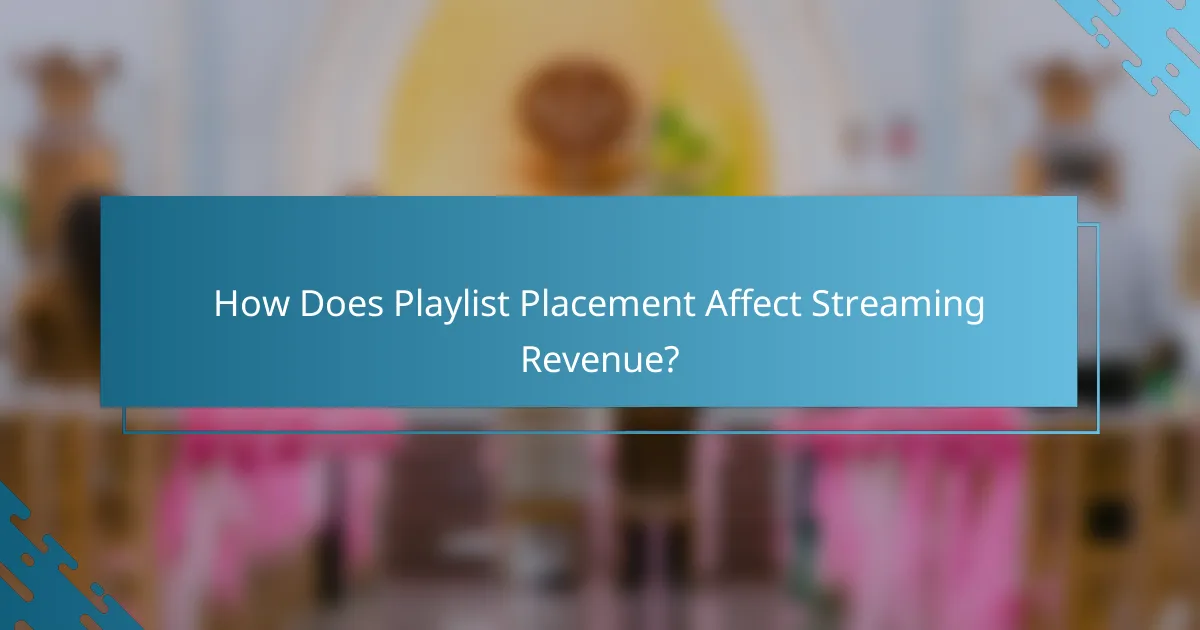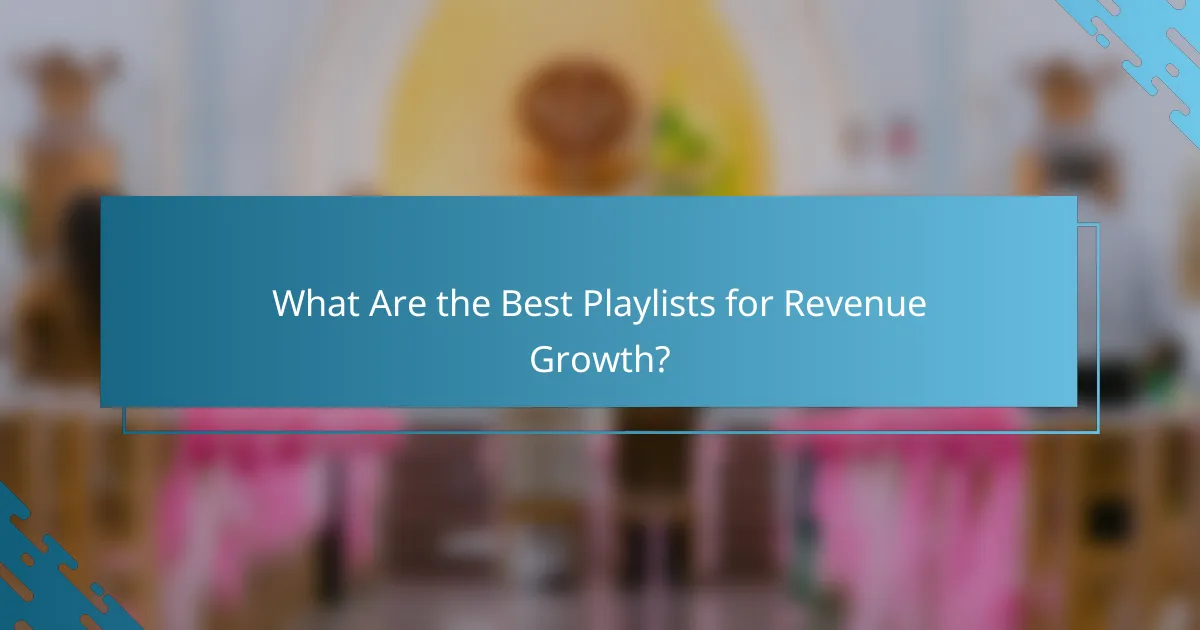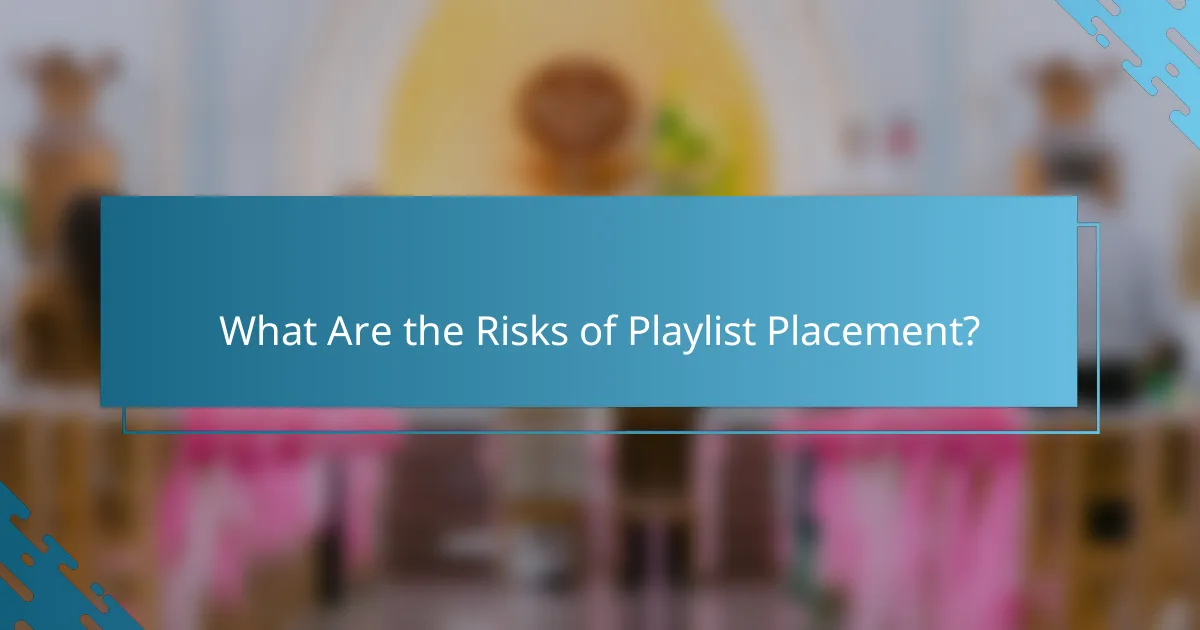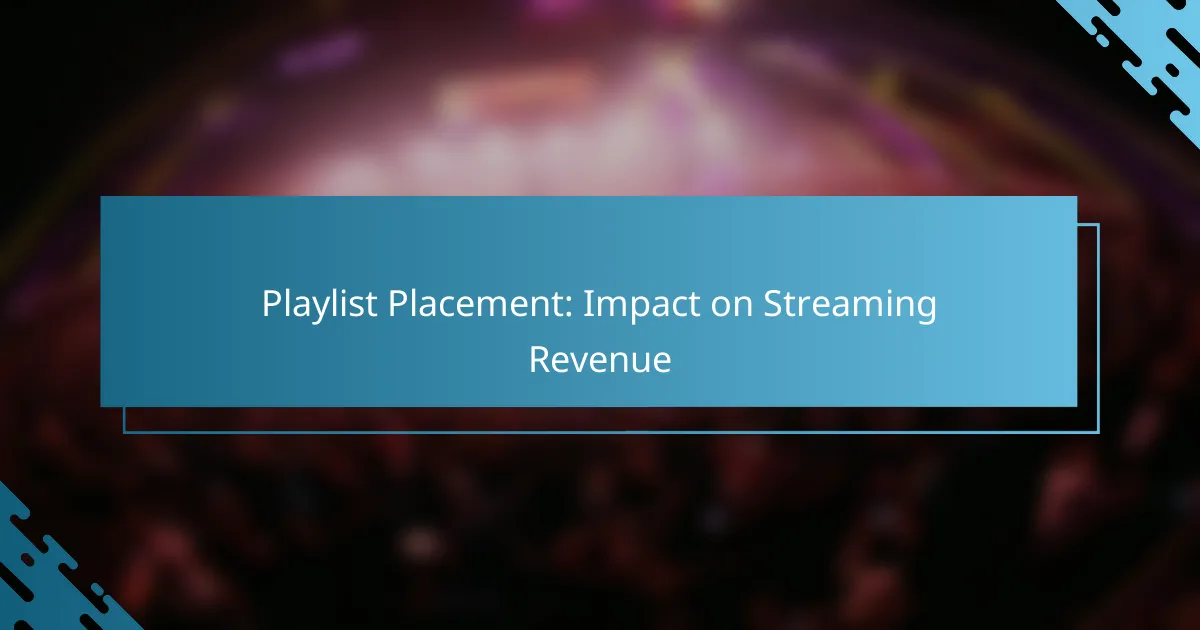Playlist placement plays a crucial role in boosting streaming revenue by enhancing the visibility of tracks, which leads to increased play counts and earnings. Being featured on popular playlists can drive significant traffic to an artist’s music, ultimately enhancing engagement and revenue potential. To maximize revenue growth, artists should strategically target playlists that offer the best exposure on platforms like Spotify, Apple Music, and YouTube Music.

How Does Playlist Placement Affect Streaming Revenue?
Playlist placement significantly impacts streaming revenue by increasing the visibility of tracks, leading to higher play counts and, consequently, more earnings. Being featured on popular playlists can drive substantial traffic to an artist’s music, enhancing overall engagement and revenue potential.
Increased visibility leads to higher streams
When a song is included in a well-curated playlist, it gains immediate exposure to a larger audience. This visibility often translates to higher streaming numbers, as listeners are more likely to play tracks that are prominently featured. For example, tracks on major playlists can see a boost in streams ranging from hundreds to thousands per day.
Artists should aim to secure placements on playlists with substantial follower counts. The more followers a playlist has, the greater the potential for increased streams and revenue. Regularly updating and promoting music can help maintain visibility and attract playlist curators.
Curated playlists drive user engagement
Curated playlists, often created by music experts or influencers, foster a deeper connection with listeners. These playlists typically feature a specific theme or mood, which encourages users to engage more with the music. When listeners find tracks that resonate with them, they are likely to save, share, and revisit those songs, boosting overall streaming revenue.
Artists can enhance their chances of being included in curated playlists by actively engaging with their fan base and promoting their music on social media. Building a strong online presence can attract the attention of playlist curators looking for fresh content.
Algorithmic playlists enhance discoverability
Algorithmic playlists, generated by streaming platforms based on user listening habits, play a crucial role in music discovery. These playlists can introduce songs to users who may not have encountered them otherwise, increasing the likelihood of new streams. For instance, playlists like Spotify’s “Discover Weekly” or Apple Music’s “For You” can significantly expand an artist’s reach.
To benefit from algorithmic playlists, artists should focus on optimizing their metadata and encouraging listeners to engage with their music. This includes asking fans to save songs, create their own playlists, and share tracks, which can signal to algorithms that the music is worth promoting further.

What Are the Best Playlists for Revenue Growth?
The best playlists for revenue growth are those that maximize exposure and engagement, particularly on platforms like Spotify, Apple Music, and YouTube Music. Each platform has unique playlists that can significantly influence streaming revenue through increased listener access and engagement.
Spotify Editorial Playlists
Spotify’s editorial playlists are curated by the platform’s team and feature a wide range of genres and moods. Getting featured on these playlists can lead to substantial revenue growth, as they often have hundreds of thousands to millions of followers.
To increase your chances of being included, focus on submitting your music through Spotify for Artists, ensuring your profile is complete and engaging. Regularly releasing high-quality tracks and promoting them through social media can also help attract attention from curators.
Apple Music Curated Playlists
Apple Music’s curated playlists are handpicked by music experts and can provide significant exposure for artists. These playlists often highlight new releases and trending tracks, making them crucial for revenue generation.
To optimize your chances of playlist placement, maintain an active presence on Apple Music by engaging with listeners and promoting your music. Collaborating with other artists and leveraging social media can also enhance your visibility and appeal to curators.
YouTube Music Algorithmic Playlists
YouTube Music relies heavily on algorithmic playlists that adapt based on user behavior and preferences. These playlists can drive substantial traffic to your music, as they are personalized for each listener.
To benefit from these playlists, focus on optimizing your video content and metadata. Engaging thumbnails, accurate tags, and compelling descriptions can improve your chances of being recommended. Consistent uploads and audience interaction can also enhance your visibility on the platform.

How to Get Your Music on Popular Playlists?
Getting your music on popular playlists is crucial for increasing streaming revenue and reaching a wider audience. Focus on strategic submissions, effective use of social media, and building connections within the music industry.
Submit to playlist curators
Submitting your tracks to playlist curators is a vital step in gaining playlist placements. Research and identify curators who align with your genre and style, as they are more likely to appreciate your music. Create a compelling pitch that highlights your unique sound and any notable achievements.
Many curators have specific submission guidelines, so ensure you follow them closely. This may include providing a short bio, links to your music, and any relevant press coverage. Be prepared for potential rejection, as curators receive numerous submissions daily.
Utilize social media for exposure
Social media platforms are powerful tools for promoting your music and increasing your chances of playlist placements. Share your music on platforms like Instagram, TikTok, and Twitter, engaging with your audience through regular updates and behind-the-scenes content. Use relevant hashtags to reach a broader audience.
Consider running targeted ads on these platforms to boost visibility. Collaborate with influencers or other artists to expand your reach. Engaging with your followers can create a loyal fanbase that supports your playlist submissions.
Network with industry influencers
Building relationships with industry influencers can significantly enhance your chances of getting on popular playlists. Attend music events, conferences, and networking sessions to meet curators, producers, and other artists. Personal connections can lead to valuable recommendations.
Utilize platforms like LinkedIn or music industry forums to connect with influencers. When reaching out, be genuine and express your admiration for their work. Offer to collaborate or share insights to foster a mutually beneficial relationship.

What Metrics Indicate Success in Playlist Placement?
Success in playlist placement can be measured through several key metrics, including stream count increases, listener retention rates, and playlist follower growth. These indicators help artists and labels gauge the effectiveness of their promotional strategies and the overall impact on streaming revenue.
Stream count increases
Stream count increases are a primary metric for assessing the success of playlist placements. When a song is added to a popular playlist, it can lead to a significant uptick in streams, often resulting in thousands or even millions of additional plays. For instance, tracks featured on major playlists like Spotify’s “Today’s Top Hits” can see their stream counts rise dramatically within days.
To maximize stream count increases, artists should target playlists that align with their genre and audience. Engaging with curators and promoting the song on social media can also enhance visibility and encourage more listeners to stream the track.
Listener retention rates
Listener retention rates indicate how well a song keeps its audience engaged after initial plays. High retention rates suggest that listeners enjoy the track and are likely to return to it, which is crucial for long-term streaming revenue. Typically, a retention rate above 50% is considered strong, meaning that more than half of listeners return to stream the song again.
To improve listener retention, artists should focus on creating high-quality music that resonates with their target audience. Additionally, leveraging storytelling in lyrics or accompanying visuals can enhance the listener’s connection to the song, encouraging repeated plays.
Playlist follower growth
Playlist follower growth measures how many new followers a playlist gains over time, reflecting its popularity and influence. A playlist that consistently attracts new followers indicates that it is successfully engaging listeners, which can lead to increased streams for featured tracks. For example, a playlist gaining hundreds of new followers weekly can significantly boost the exposure of its songs.
To foster playlist follower growth, curators should regularly update their playlists with fresh content and promote them across social media platforms. Collaborating with artists to create exclusive tracks or remixes can also draw attention and encourage more users to follow the playlist.

What Are the Costs Associated with Playlist Placement?
Playlist placement can incur various costs that impact an artist’s overall revenue. Understanding these expenses is crucial for maximizing the benefits of being featured on popular playlists.
Marketing and promotion expenses
Investing in marketing and promotion is essential to enhance the chances of playlist placement. This can include social media advertising, influencer partnerships, and targeted campaigns, which may range from a few hundred to several thousand dollars depending on the scope.
Effective marketing strategies often involve creating engaging content and leveraging analytics to track performance. Allocating a budget for these activities can significantly increase visibility and attract playlist curators.
Fees for playlist submission services
Many artists use playlist submission services to facilitate placement on popular playlists. These services typically charge fees that can vary widely, from around $20 to several hundred dollars per submission, depending on the service’s reputation and reach.
When choosing a submission service, it’s important to research their track record and understand what they offer. Some may provide additional promotional support, while others focus solely on submission, so consider what aligns best with your goals.
Potential loss of revenue from exclusivity deals
Exclusivity deals can limit an artist’s ability to distribute their music across multiple platforms, potentially leading to lost revenue. If a song is exclusively available on one platform, it may miss out on streams from users on other services.
Artists should weigh the benefits of increased exposure against the potential downsides of exclusivity. Negotiating terms that allow for broader distribution while still gaining playlist placement can help mitigate revenue loss.

What Are the Risks of Playlist Placement?
Playlist placement can significantly impact an artist’s streaming revenue, but it also comes with various risks. These risks include dependency on playlist algorithms, potential loss of creative control, and fluctuating listener engagement.
Dependency on Algorithms
Relying on playlist placement means artists must navigate complex algorithms that determine which songs get featured. Changes in these algorithms can drastically affect visibility and, consequently, revenue. For example, a song that performs well one week may drop off playlists the next due to shifts in algorithmic preferences.
Artists should diversify their promotional strategies rather than solely depending on playlists. Engaging directly with fans through social media or live performances can help mitigate the risks associated with algorithm changes.
Loss of Creative Control
When artists secure playlist placements, they may face pressure to conform to specific genres or trends, which can dilute their unique sound. This loss of creative control can lead to dissatisfaction and impact long-term artistic identity. For instance, an artist might feel compelled to produce more commercial tracks to maintain playlist visibility.
Maintaining a balance between commercial appeal and artistic integrity is crucial. Artists should consider how much they are willing to adapt their sound for playlist inclusion and weigh that against their long-term goals.
Fluctuating Listener Engagement
Playlist placements can lead to spikes in streaming numbers, but these may not always translate to sustained listener engagement. Once a song is removed from a popular playlist, artists may see a significant drop in streams and revenue. This fluctuation can create uncertainty in income, making financial planning challenging.
To counteract this, artists should focus on building a loyal fan base. Engaging listeners through consistent content and interaction can help maintain interest even when playlist placements change.
